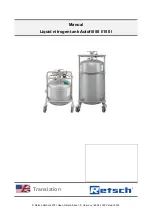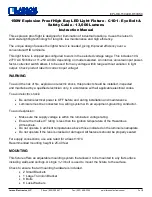
Safety and occupational health instructions
10
2.2 Safety instructions on the handling of liquid nitrogen
2.3 Safety instructions on the handling of liquid nitrogen (Oxygen deficiency)
The main components of air according to volumes are as follows:
– Oxygen O2 21 %
– Nitrogen N2 78 %
– Argon Ar 1 %
The gases contained in the atmosphere are not toxic. However, a change in concentration (in
particular changes to the oxygen concentration) may have effects on life and burns. It is
therefore essential for the air breathed in to contain sufficient oxygen (> 19 %).
Humans cannot detect changes in the composition of air within the time that will actually be
necessary because the components are colourless and odourless.
2.3.1 Dangers
A danger of suffocation exists as a result of the normal evaporation of the liquid nitrogen that
pushes out the oxygen in the air. An oxygen deficiency is dangerous and can cause death
through suffocation. The reaction of the organism to oxygen deficiency will differ greatly
depending on the individual. It is not possible to provide precise and generally applicable
information on the symptoms of an oxygen deficiency.
Example: under normal conditions (20° C; 1013 mbars) 1 l liquid nitrogen evaporates to produce
680 l nitrogen gas.
2.3.2 Causes
An oxygen deficiency may arise during the following work or in the following conditions:
– Nitrogen as liquid or gas
– Natural evaporation of liquid nitrogen
– Refilling of liquid nitrogen
– Leaks in containers for liquid or gaseous nitrogen
– Defect in the air feed or outlet
– Tipping over of the container
This list is not complete.
2.3.3 Recommendations
In order to prevent the danger of an oxygen deficiency, the following measures must be taken.
The vessel:
• must be kept in a vertical position.
• must be provided with a suitable insulating lid.
•
must be protected from direct sunlight and may not be set up near heat
sources.
•
may not be transported in vehicles in filled state.
•
must be protected from impact, knocks and rapid movements.
• Ventilate all installation rooms constantly and appropriately.
•
Wear protective clothing (suitable gloves, goggles or face protection and
safety shoes).
• Check the oxygen content of the room constantly.
• Always carry an oxygen metre.
• Only trained personnel may work with liquid nitrogen.











































